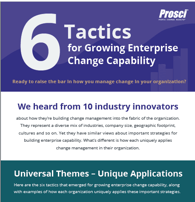Failing to assess the organisation’s readiness is one of the biggest errors leaders can make when embarking on a major change effort. As a result, they risk imposing change on an organisation that is unwilling or unable to adopt it. Executives are often so focused on what they have concluded is the right solution, that they often overlook the organisations’ capacity to make the change. This leads them to vastly underestimate the time, resources, and effort that will be required to be successful. Paradoxically, a large part of the success hinges on the leadership’s active role in supporting, equipping, and preparing people to make change. To do that, they need to first assess where they are and what gaps they need to fill.
To visualise this, let’s use a popular metaphor for a difficult undertaking, climbing Mount Everest. If you were going to send someone to climb Mount Everest, would you send them without regard for their physical and mental capacity to manage the journey? Would you send them knowing that they have not yet acquired the skills to make the climb? Would you send them without first obtaining the proper oxygen, mountaineering equipment, a guide, or Sherpas to assist them? Similarly, not equipping your organisation for change puts employees, customers, the management team, and the shareholders at risk.
Yet, leaders often expect their people to take on monumental change efforts without providing them with the training, tools, and equipment they need to reach their goal. As if things could not get any worse, some leaders even ask them to do it again and again and again allowing the pressures of the journey to overwhelm even the most committed employees, leaving them helpless, discouraged, sceptical, and disengaged.
How to Assess if Organisation is Ready for Change?
Smart change leaders first determine their organisation's fitness for making the change then build their plans to manage it forward thus mitigating the risk and raising the probability of success. A good readiness assessment should collect data on and evaluate at least these seven key elements:
- Leadership’s capacity to lead the change: First and foremost, people need to feel that the leaders have the competency and authority to lead the change. Whether or not the leadership has the credibility, knowledge, and skills to lead the change will be a judgement the employees will make at the outset. If they believe the leadership is lacking, they are unlikely to accept the change and put forth the extra effort to make it a success even if it is the right change.
- Middle Management’s capacity for change: In any change, people managers play a key role as the primary conduit for information, feedback, and addressing resistance. If management does not understand or is unwilling to support the change, they can also be a key barrier. The level of support, enthusiasm, and energy people manager’s put into helping achieve change directly impacts the level of success. Assessing their status is key to ensuring the organisation is prepared.
- The organisation's history with change: This focuses both on the degree to which past efforts have achieved their benefits and goals and the manner in which this If previous change efforts were unsuccessful, took a long time to realise benefits, or were launched with little regard for the individual change process (read ADKAR), it could indicate that organisation is not ready to accept new change.
- Urgency for the change: This part of an assessment would seek to know if people in the organisation are aware of the need for change and feel that the case has made for change to occur now. If people are not aware of the need or do not feel it is urgent, they can decide it does not fit into their priorities and either resist or select not to adopt the change.
- Capacity for change: Employees will make their own assessment on their capacity for change. If the ground work in points 1-3 is not laid, if they are over tasked with daily operations, if they don’t feel they have the skills, time, or resources to make change, they will likely not be willing to adopt it. Similarly, if they are already overwhelmed by changes that are already in process, they may experience change fatigue leaving them with no room to go through the emotional and mental stress of an additional change.
- The Impact of the change: Knowing the impact of the change at the group and even the individual level is a key step to assessing and preparing the organisation. Often, we find that organisations have not taken the time to determine the differences between the current and the future state opting instead to simply focus the future state.
Not understanding what the change is and how it will impact people’s daily work, leaves the people to assess this for themselves, and without the proper information, this can lead them to jump to conclusions, misunderstand the specifics, succumb to rumour, or simply chose not address the change at all. - Purpose of change: One of the realities of the current workforce is that they need to feel that the change is not just in the interest of the organisation but that it is in their interest as well. They need to know if the change will help them in the fulfilment of their purpose in the organisation. Research has shown that people are able to go to great lengths to adopt change if they feel it fills a purpose they buy into.
If the change does not support their personal goals and needs, they are not likely to make it a priority. While this is often referred to as their WIIFM (what’s in it for me), it can also refer to a greater purpose they believe they are supporting by working for the organisation. If the purpose for the change is not clear, compelling, or communicated on an individual level, then it is unlikely the organisation is ready for it.
Download: 6 Tactics for Growing Enterprise Change Capability
Of course, organisational readiness is not a black or white question. Readiness exists on a continuum and leaders will have to continuously probe, sense, and then decide whether they need to do more to drive readiness. Unfortunately, more often than not, the tendency is to not address these topics at all.
The reasons for this are varied. In many cases, leaders have not been educated in the people side of change so they are not aware of the need. For some, they believe that if the change is the right one, employees will simply jump on board and enthusiastically adopt the change. For others, they may feel that raising these topics will create resistance or at the least raise challenging questions about the change.
How to Succeed When Implementing Organisational Change?
Yet, these circumstances are exactly why raising these questions are so important. Answering these critical questions allow insight into the organisation readiness enabling leaders to scan and reveal hidden challenges that would eventually jeopardise the success of a change.
Successful organisations succeed not simply because of the presence of charismatic and visionary leaders that know it all. They succeed because these leaders understand the people that make up the organisation and their willingness and capability to drive and adopt change. The best leaders are the ones that prepare and equip their people and enable them the greatest opportunity for success.
Want to Develop Your Change Management Capability?
To learn more about what it takes to build enterprise change capability, watch our FREE webinars on-demand. You can also keep an eye out for our upcoming live webinars. See what topics we've got coming up!
If you want to speed up your response to change, we can offer you change management support and a range of virtual Prosci workshops for sponsors, managers and project managers.
If you would like to learn about Prosci's change management methodology and become a successful change leader, find out more about our three-day learning experience and gain a world leading certification.
During the course, you will learn how to apply Prosci’s methodology to an existing project and network with other change leaders. Download our Change Management Practitioner Programme brochure to find out more about the course. The programme is also available on a private-basis for your organisation.



